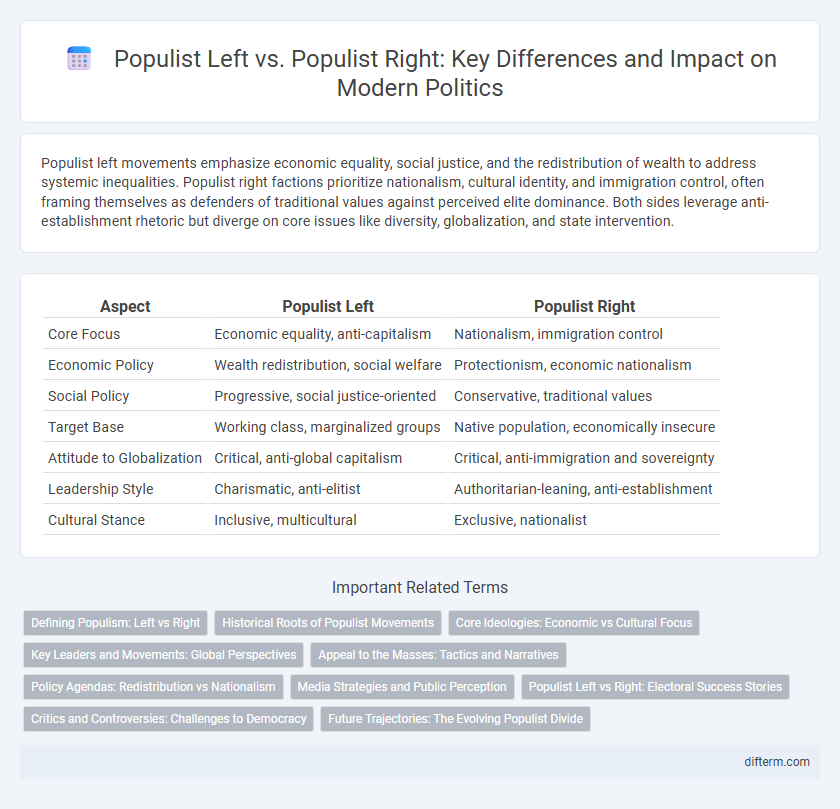Populist left movements emphasize economic equality, social justice, and the redistribution of wealth to address systemic inequalities. Populist right factions prioritize nationalism, cultural identity, and immigration control, often framing themselves as defenders of traditional values against perceived elite dominance. Both sides leverage anti-establishment rhetoric but diverge on core issues like diversity, globalization, and state intervention.
Table of Comparison
| Aspect | Populist Left | Populist Right |
|---|---|---|
| Core Focus | Economic equality, anti-capitalism | Nationalism, immigration control |
| Economic Policy | Wealth redistribution, social welfare | Protectionism, economic nationalism |
| Social Policy | Progressive, social justice-oriented | Conservative, traditional values |
| Target Base | Working class, marginalized groups | Native population, economically insecure |
| Attitude to Globalization | Critical, anti-global capitalism | Critical, anti-immigration and sovereignty |
| Leadership Style | Charismatic, anti-elitist | Authoritarian-leaning, anti-establishment |
| Cultural Stance | Inclusive, multicultural | Exclusive, nationalist |
Defining Populism: Left vs Right
Populism on the left typically emphasizes social justice, wealth redistribution, and challenging economic elites, while populist right movements prioritize national sovereignty, anti-immigration policies, and cultural identity. Both share a distrust of established political institutions and elites but diverge sharply in their solutions and core values. The left frames populism through economic inequality, whereas the right centers its rhetoric on preserving traditional national identity.
Historical Roots of Populist Movements
Populist movements on both the left and right have origins rooted in economic distress and social upheaval during the late 19th and early 20th centuries, where marginalized groups sought to challenge established elites. The Populist Party in the United States, emerging in the 1890s, exemplified left-wing populism by advocating for agrarian interests and monetary reform. Conversely, right-wing populism has historical ties to nationalist and protectionist reactions against perceived threats to cultural identity and economic stability, often gaining momentum during periods of immigration and rapid social change.
Core Ideologies: Economic vs Cultural Focus
Populist left movements prioritize economic issues such as wealth redistribution, social welfare expansion, and labor rights, aiming to address income inequality and corporate power. In contrast, populist right factions emphasize cultural and national identity concerns, advocating for immigration control, traditional values, and sovereignty. These divergent core ideologies shape their policy agendas and electoral strategies, reflecting economic grievances versus cultural anxieties.
Key Leaders and Movements: Global Perspectives
Populist left leaders such as Bernie Sanders in the United States and Andres Manuel Lopez Obrador in Mexico emphasize social justice, wealth redistribution, and anti-corruption, mobilizing movements centered on economic equality and inclusive governance. On the populist right, figures like Jair Bolsonaro in Brazil and Viktor Orban in Hungary focus on nationalism, immigration control, and traditional values, driving movements that challenge globalism and prioritize sovereignty. Both wings leverage charismatic leadership and media-savvy tactics to influence public opinion and reshape political landscapes worldwide.
Appeal to the Masses: Tactics and Narratives
Populist left movements emphasize economic inequality and social justice, using narratives that highlight corporate greed and wealth redistribution to appeal to working-class voters. Populist right factions focus on national identity and cultural preservation, exploiting fears of immigration and globalization to mobilize support. Both employ direct, emotionally charged rhetoric and simple, relatable messaging to maintain a strong connection with their respective base.
Policy Agendas: Redistribution vs Nationalism
Populist left movements prioritize wealth redistribution through progressive taxation, social welfare expansion, and labor rights to address economic inequality and promote social justice. Populist right agendas emphasize nationalism by advocating for stricter immigration controls, protectionist trade policies, and the preservation of traditional cultural identities. These contrasting policy priorities reflect fundamental differences in addressing economic grievances and national sovereignty issues.
Media Strategies and Public Perception
Populist left movements leverage grassroots social media campaigns and alternative news outlets to amplify messages of economic equality and social justice, fostering strong public identification with marginalized groups. In contrast, populist right factions often utilize sensationalist rhetoric and fear-based narratives across mainstream and fringe media to galvanize nationalist sentiments and skepticism toward elites. Public perception is shaped by these divergent strategies, with the left viewed as champions of inclusion and the right as defenders of tradition and security.
Populist Left vs Right: Electoral Success Stories
Populist left movements, such as Spain's Podemos and Greece's Syriza, have achieved electoral success by mobilizing working-class voters through anti-austerity and social justice platforms. In contrast, populist right parties like Italy's Lega and France's National Rally capitalize on nationalist rhetoric and immigration control to secure broad support. These divergent strategies reflect contrasting appeals to economic insecurity versus cultural identity in contemporary democratic elections.
Critics and Controversies: Challenges to Democracy
Populist left movements face criticism for promoting economic policies that opponents argue undermine market stability and fiscal responsibility, while populist right factions are often scrutinized for nationalist rhetoric that risks deepening social divisions. Both sides encounter controversies over accelerating polarization, which challenges democratic institutions by fostering distrust in traditional political elites and media. Critics highlight that these dynamics exacerbate democratic fragility, potentially eroding checks and balances essential for maintaining inclusive governance.
Future Trajectories: The Evolving Populist Divide
Populist left movements are increasingly prioritizing economic equality and social justice reforms, pushing for expansive welfare policies and stronger labor rights to address systemic inequalities. In contrast, populist right factions emphasize nationalist rhetoric, immigration control, and cultural preservation, often linking economic grievances with identity politics. Future trajectories suggest these divides will deepen as global challenges like economic instability and cultural polarization intensify, shaping divergent political agendas and voter bases worldwide.
populist left vs populist right Infographic

 difterm.com
difterm.com